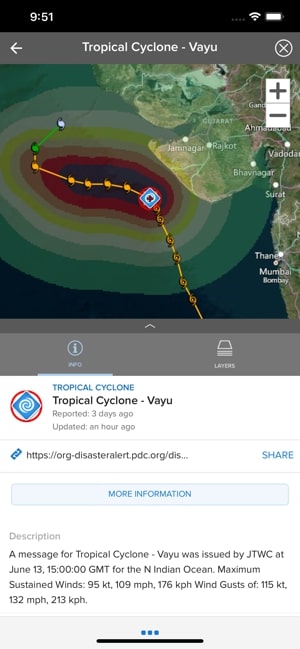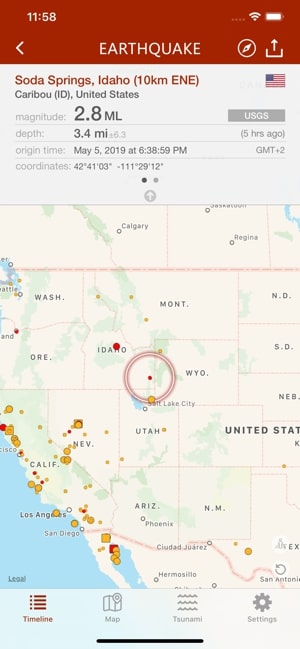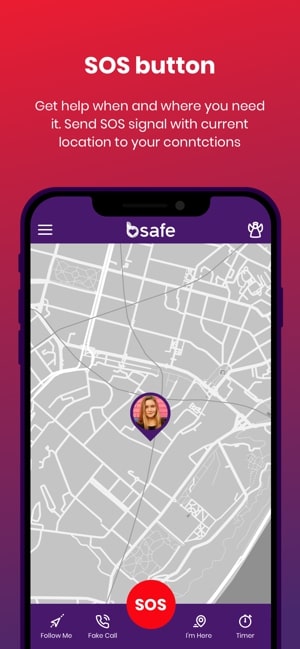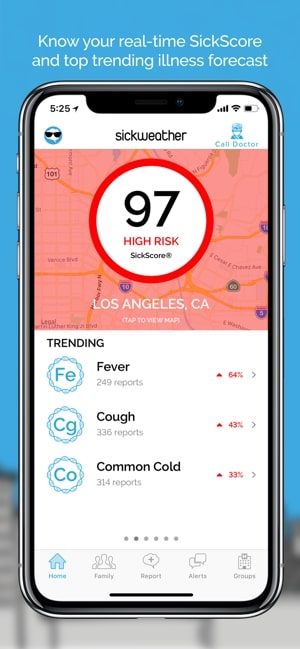With so much going on in the world right now, from pandemics to protests and the zombie apocalypse (OK, we’re just kidding about that one), it’s more important than ever before to stay connected to what’s happening around us, whether you’re in your local area or traveling.
Emergency apps not only keep you informed of local incidents or reported crimes, they can also warn you of impending natural disasters or weather events like tornadoes or earthquakes, keep you safe on your way home from a night out, update you while you’re traveling, and even allow you to communicate with your loved ones in the event wireless and phone networks are unavailable. We’ve hand-picked some of the best apps for almost any emergency situation, whether you’re heading to a protest or want to stay informed while on the road.
Best for emergency alerts
Emergency
This American Red Cross app is your must-have in case of emergencies, providing real-time local alerts for hazards and severe weather including earthquakes, hurricanes, thunderstorms, wildfire, tornadoes, and more. There’s a handy toolkit that includes a flashlight, strobe light, and audible alarm, as well as an easy messaging system to let loved ones know you’re safe. Receive alerts of severe weather warnings or hazards in your area or check up on loved ones, and the app can even help you create your own emergency plan and has a map showing open Red Cross shelters in your vicinity. Much of the emergency information and content — such as what you should and shouldn’t do in specific types of severe weather — is preloaded, so it’s easily accessible offline.
Citizen
Citizen has become one of the most popular safety apps of 2020 following the recent protests across the U.S. — but it’s also great for keeping track of what’s happening in your neighborhood and staying safe generally, too. Incident alerts are pinged to those within the vicinity, and the app works similarly to police scanner apps, showing you details of incidents and a map of their location. If you stumble upon an incident unfolding, you can share a live broadcast in the app, always ensuring you stay safe and don’t put yourself in harm’s way. Citizen also recently introduced SafeTrace, a contact-tracing feature that provides up-to-date information about the coronavirus pandemic in your city, state, or country.
Best for natural disasters
Disaster Alert
Built on the PDC’s DisasterAWARE platform, Disaster Aware’s interactive map displays 18 different types of active hazards, with near real-time updates. Not only can you get early-warning alerts on tsunamis, tornadoes, hurricanes, wildfires, earthquakes, and other hazards, you can also be updated on major weather events like high winds and storms. Those who want the full story can view situational analysis reports and map overlays that show global cloud coverage, population densities, and other relevant information. It’s easy to customize alerts and notifications based on your location and hazard severity, and there are customizable background maps too.
Earthquake
The world’s number one earthquake app draws data from multiple reliable sources like U.S. Geological Survey, GeoScience Australia, and the European-Mediterranean Seismological Center, and can send up to four alerts based on the location and/or magnitude of a quake. The map shows different sized and colored circles relating to the time and magnitude of earthquakes worldwide, and it’s easy to filter by location or magnitude. Clicking on an event shows more detailed data, such as magnitude, depth, location coordinates, and origin time — and it’s easy to export data to Google Earth or share it with friends and family via email, Facebook, or Twitter.
Check out the handy Today Widget for details of any quakes in your country in the last 24 hours, or view historic information dating back to 2013 in the detailed catalog of worldwide earthquakes. Earthquake supports 15 different languages, as well as 3D Touch and Haptic Feedback. Unfortunately, there’s no Android version available — but the iOS app works with Siri, so you can just say “Hey Siri, what are the latest earthquakes in [your location]?” to find out what’s happening near you.
Best for personal safety
Bsafe
Whether you’re heading out on a blind date or just walking home after work, Bsafe is the most popular personal safety app on the market right now. Nominate a guardian (or three) to receive a call in an emergency, which you activate by pressing the SOS button or saying a key phrase when the app is open. You can automatically record and stream video in an emergency too, or ask your guardian to follow your location on the map, as if they’re walking you home. The app lets you send your exact location, in case you need a ride home, and if that date isn’t going to plan, you can even receive a fake phone call, giving you the perfect excuse to leave. Bsafe is free to use, but there’s the option to sign up for a premium subscription for 24 hours — ideal for a night out across town — or choose from a weekly or annual subscription from $2.
Life360
Think of Life360 as a family safety app — a way to keep your family and friends connected and eliminate the need for those “When will you be home?” texts. You can keep tabs on the real-time locations of friends and family and set the app to send alerts when they leave locations like school, work, or home. Once you’ve set up your circle, there’s a private map that lets you view real-time locations, as well as location history, and you can send texts and photos through the secure private chat.
Parents can view information after a drive to improve safety (so you can see how fast your teens were driving), and there’s even a Car Crash Detection service that uses the accelerometer on your phone to detect a crash and automatically contact emergency services. Life360 also has a panic alert that sends your location via text, email, or voice call to your contacts, and there’s a lost/stolen phone tracking feature too. You can choose from a range of subscriptions, starting from $3 per month, with a seven-day free trial.
Best for communication
Zello Walkie-Talkie
We’ve included Zello in our list of the best walkie-talkie apps around, and that’s because it’s simple to use yet packed with features. In the event mobile phone networks are down, Zello is a great app to keep handy so you can get in touch with and check on loved ones. Zello allows you to create group chats, great for contacting the whole family or a group of friends in an emergency, and the voicemail-like system records any messages, playing them back automatically as soon as you open the app. If you can’t voice chat, you can send texts, images, or alerts.
Best for travel
Smart Traveler
If you don’t mind downloading an official app from the U.S. Department of State, you’ll find Smart Traveler invaluable for your next trip. Just search for the country you’re visiting to pull up a whole host of information, from health, safety, and security advice to visa information and details of local U.S. embassies and consulates. Create personalized itineraries, add notes, and organize your upcoming trips, and view travel advisories for destinations you’re planning to visit at a glance. There’s also the option to enroll in the State Department’s Smart Traveler Enrollment Program. It’s free and means the State Department can better help you in an emergency — like losing your passport or a natural disaster happening while you’re on vacation.
Sickweather
With the ongoing coronavirus pandemic, we’re all being extra cautious when it comes to our health. If you’re planning a vacation or work trip, Sickweather can alert you to outbreaks of contagious illness in the area you’ll be visiting, helping keep you and your loved ones safe. The app tracks and maps reports of contagious illness from social media as well as crowdsourcing directly from users, and you can report illness or post messages to a range of locations, like nearby schools, your workplace, restaurants, and other frequently visited places.
When entering a “sick zone,” the app provides real-time alerts for illnesses like whooping cough, flu, and norovirus, as well as 20 other conditions. Keep an eye on the interactive map, where blue “Sick” markers will appear in any areas a contagious illness has been reported. Tap these for more information and you’ll be able to see how recently an outbreak was reported due to color-coding, such as red for reports within the past 24 hours. You can instantly view the “SickScore” for a given location and see the breakdown of the score — for example, how many reports of the common cold, cough, or fever were reported in the area — before deciding whether to visit, and the app even connects to your smart thermometer. There’s an app for Apple Watch, too, which comes with a 20-second hand-washing timer.
Best for medical emergencies
Medical ID
From serious car accidents to collapsing on the street, there are plenty of situations where somebody else may need access to your medical information, and if it’s locked safely away in your phone, that’s a problem. Although iOS users have access to the built-in Medical ID feature, for the rest of us, there’s the Medical ID app, designed to give first responders and medical professionals easy access to your medical information from your lock screen. It’s easy to set up a profile with your essential information, like any existing medical conditions, medications, or known allergies, as well as your blood type. You can set up emergency contacts that anybody can call without unlocking your phone, and there’s even a feature to send a one-tap SMS alert with an estimate of your location.
When accessing your medical profile, the address and GPS coordinates for your location can be viewed, making it easy to give emergency services accurate information. Although the app is free, you can gain access to additional features like unlimited profiles — great for families — and multiple SMS alert contacts by upgrading to the premium version for $5.
First Aid: American Red Cross
Although we should all know some First Aid for emergencies, not everybody does — and that’s where the American Red Cross First Aid app comes in handy. It aims to guide you step by step through common first aid scenarios, like treating a bite or sting, or what to do in a diabetic emergency, and it’s fully integrated with 911, so you can quickly call EMS if required. As well as first aid advice, you can locate nearby hospitals and view handy safety tips for natural disasters or severe weather conditions, and most of the content is preloaded, so you can access it even if you’re offline or have no reception. There’s even a handy toggle to switch instantly to Spanish.



































